
Each 12 October is celebrated as United Nations (UN) World Migratory Bird Day.
The Thammasat University Library collection includes books about different aspects of the life and activities of migratory birds.
The UN website explains:
World Migratory Bird Day is an Annual Global Celebration
World Migratory Bird Day (WMBD) is an annual awareness-raising campaign highlighting the need for the conservation of migratory birds and their habitats. It has a global outreach and is an effective tool to help raise global awareness of the threats faced by migratory birds, their ecological importance, and the need for international cooperation to conserve them.
Every year people around the world take action and organize public events such as bird festivals, education programmes, exhibitions and bird-watching excursions to celebrate WMBD. All these activities can also be undertaken at any time on the year because that countries or regions observing the peak of migrations at different times, but the main days for the international celebrations on the second Saturday in May and in October.
Connecting Events with a Global Campaign and Theme
World Migratory Bird Day activities take place in many different countries and places across the globe – united by a common campaign and theme. If you are interested in organizing an event to mark WMBD, register your planned activity. In this way, individual events can be shared with others around the world and help inspire them to take action too. […]
We are excited to announce that for the first time ever, World Migratory Bird Day focuses on the importance of insects for migratory birds, and highlight concerns related to decreasing populations of insects.
Insects are essential sources of energy for many migratory bird species, not only during the breeding seasons but also during their extensive journeys and greatly affect the timing, duration, and overall success of bird migrations.

Along their migration routes, birds actively seek out insects in fields, forests, wetlands, and various habitats during stopovers. The timing of bird migration often coincides with peak insect abundance at stopover locations, supplying nourishment for birds to replenish their energy reserves before continuing their journeys.
The loss and disturbance of insect populations at breeding sites and along avian migration routes threaten bird survival and well-being. Natural spaces like forests and grasslands that have been transformed or endangered by intensive agriculture and urban development and its effects such as light pollution can result in a decline in insect populations.
Pesticides and herbicides designed to protect crops harm insects that birds rely on for food. A scarcity of energy- and protein-rich insects can hinder bird migration and breeding, leading to weakened immune systems, reduced reproductive success, and increased mortality rates for both adult birds and their offspring.
Birds play crucial roles in pollination and pest control, and a lack of insects disrupts these ecosystem functions. Overpopulation of certain insects, without natural predators from birds, can also cause outbreaks that damage plant health and agriculture.
The World Migratory Bird Day campaign in 2024 stresses the need for proactive conservation measures. This includes reducing the use of pesticides and fertilisers, and where possible, switching to organic farming. Other measures include maintaining and connecting areas of natural vegetation which provide food and shelter for birds and other species, in agricultural landscapes.
In 2024, World Migratory Bird Day is being celebrated on two days, 11 May and 12 October, aligning with the cyclic nature of bird migration in different hemispheres.
“Water: Sustaining Bird Life!” was the theme of World Migratory Bird Day in 2023. Water is fundamental to sustaining life on our planet. Virtually all migratory birds rely on water and its associated habitats at some point during their life cycles. Lakes, rivers, streams, ponds, wetlands, and coastal waters are all vital for feeding, drinking, or nesting, and as places to rest and refuel during long seasonal migrations. Unfortunately, these aquatic ecosystems are becoming increasingly threatened around the world, and so are the migratory birds that depend on them. The increasing human demand for water, as well as pollution and climate change, is having a direct impact on the quantity and quality of water resources and on the conservation status of many migratory bird species.
“Dim the Lights for Birds at Night” was the theme of World Migratory Bird Day in 2022, focusing on the topic of light pollution and its impact on migratory birds. The campaign stimulated hundreds of events in all corners of the world and helped focus global attention on the topic of light pollution. Light pollution is a significant and growing threat to wildlife including many species of migratory birds. Every year, light pollution contributes to the death of millions of birds. Attracted by artificial light at night, particularly when there is low cloud, fog, or rain or when flying at lower altitudes, migrating birds become disoriented and may end up circulating in illuminated areas. Depleted energy reserves put them at risk of exhaustion, predation, and often fatal collision with buildings. One of the highlights of the campaign was the production of a 2-minute animation showing the impact of light pollution on a small migratory songbird. The clip was produced in cooperation with The Cornell Lab of Ornithology and was made available in all UN languages.
“Sing, Fly, Soar – Like a Bird!” was the theme for WMBD 2021, focusing on the phenomena of “bird song” and “bird flight”. This was used as a way to inspire and connect people around the world in their shared desire to celebrate migratory birds and to unite around a common, global effort to protect birds and their habitats. During the pandemic, bird song has been a source of comfort and joy for many people around the world, connecting them to each other as well as to nature. Although the pandemic has been an unprecedented challenge for humankind, it has brought a new level of awareness and appreciation of birds and the importance of nature for our well-being. For WMBD 2021, the SING and DANCE #LikeABird challenge was created to invite people to use their creative expression as a way to raise awareness of migratory birds and their conservation.
“Birds Connect Our World” was the theme for WMBD 2020. Connectivity is essential for migratory species, and important for a wide variety of ecological functions. It describes the natural and necessary movement of species and the flow of natural processes that sustain life on Earth. With 1 million species facing the risk of extinction within our generation, connectivity has become a central topic for biodiversity and sustainability. Migratory species move across the globe, running, swimming, flying, connecting countries, people and continents through their migration routes. This migration can only be accomplished when animals are able to access the different sites and habitats that they rely upon along their pathways.

(All images courtesy of Wikimedia Commons)

